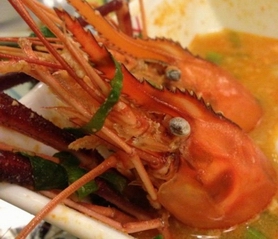 Typically, prawn farmers in Chanthaburi province stock their ponds in January or February, with the intention of harvesting that crop just before April’s Songkran holiday. This year, however, things have turned out differently.
Typically, prawn farmers in Chanthaburi province stock their ponds in January or February, with the intention of harvesting that crop just before April’s Songkran holiday. This year, however, things have turned out differently.“Only 30% of all farmers have started stalking,” says Chakarin Pecharoen, Chairman of the Chantaburi Shrimp Farmers Club. “[The last quarter of 2012] netted a decrease of around 20-to-30%. But I have a deep feeling that the production in this first quarter might turn out to be something very horrible.”
Many shrimp ponds in Chanthaburi and throughout Thailand remain bone dry at this late point in the season because of fears about a scourge affecting crustaceans regionwide. EMS (Early Mortality Syndrome) is a phenomenon as mysterious as it is deadly and in the past three years, it has threatened to undermine Asia’s commercial shrimping industry.
Reports of EMS first surfaced in 2009 in China, where farmers noticed that their prawns had begun dying en masse, without any identifiable cause.
In the commercial shrimping industry, where occasional epidemics are par for the course, a Chinese die-off failed to qualify as news. However, as the months proceeded and dead shrimp continued to pile up, the statistics became too massive to ignore.
By 2011, shrimp farms in China’s Hainan, Guangdong, Fujian and Guangxi provinces were suffering losses as great as 80%. Without a specific pathogen to blame, farmers christened the disease according to its immediate effect – Early Mortality Syndrome.
From China, EMS made the leap to Vietnam and to Malaysia, where it left similarly massive swathes of devastation. In 2011 and 2012, EMS wreaked havoc on Vietnam’s shrimping industry. The province of Tra Vinh saw 330 million shrimp die in the month of June 2011 alone. Aquaculture news outlet The Fish Site used terms like “widespread devastation” in describing the outbreak.
Malaysia, where EMS first emerged in 2010, displayed a similar pattern. Between 2010 and 2011, its commercial prawn industry demonstrated a year-on-year decrease in production of roughly 42%.
“It’s a huge phenomenon,” says Daniel Gruenberg, CEO of Sea Garden Foods, an aquaculture and shrimp farming company in Chonburi province. “Just to give you a measuring stick, I had some friends that sell [prawn feed] and if they look at their year-on-year feed sales they’re down 70% to 80%. It’s massive.”
In Thailand, EMS has not racked up a death toll as large as those seen in China and Vietnam. However, since the phenomenon’s 2011 appearance in the Kingdom, its effect has been drastic, and increasingly difficult to ignore.
EMS first arrived in the eastern provinces of Chanthaburi and Rayong, where it has caused year-on-year decreases in prawn production as high as 40% by some accounts.
Even worse than the EMS itself is the panic it has engendered among local farmers. Gruenberg speculates that as many as 80% of the shrimp farmers in eastern Thailand have chosen to leave their ponds dry, rather than risk their capital by stocking shrimp that may or may not survive to maturity.
Though his estimate employs figures more cautious than Gruenberg’s, Dr. Putth Songsangjinda, Director of the Marine Shrimp Culture Research and Development Institute, concurs.
“The real problem is panic among shrimp farmers,” he says. “With farmers delaying their stocking, it could adversely affect Thailand’s whole shrimp production.”
For Thailand’s billion-dollar-plus yearly shrimping industry, these drops in production could prove catastrophic. The country’s shrimp exports are already in a less-than-ideal state, having suffered steady declines since their peak in 2000. With a 26.7% year-on-year drop in production between 2011 and 2012, the industry is ill positioned to withstand further shocks.







